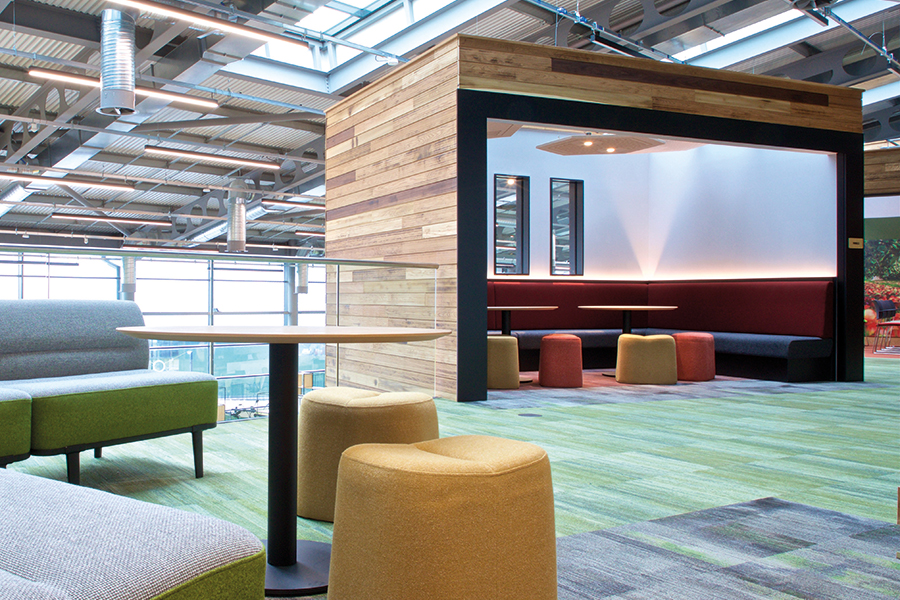An introduction to research commissioned by Milliken & Company with regards to designing a neuro-inclusive workplace. By MANISHA SELHI and ALISON KITCHINGMAN
As a flooring designer and manufacturer, Milliken & Company needs to understand and be at the forefront of the most pertinent issues informing workplace design.
This is why Milliken & Company sought to understand better how to design a neuro-inclusive workplace and how their flooring products can facilitate this. It became apparent there were some gaps in understanding and guidance in this area.
Milliken therefore commissioned HCG to carry out research and produce a practical report on how workplaces can be improved for everyone.
Now, with the aim of raising awareness and understanding of the specific needs and requirements of a neurodiverse workforce, Milliken is sharing the findings and recommendations in a series of five articles.
The information will be presented in bite-size digestible chunks, beginning with an overview and the methodology used. The articles will continue to explore how the research is influencing Milliken’s choice of colours for their flooring collections.
The full report is available to download at any time.
In the White Paper HCG distil their expertise in designing workplaces and cultures, and with the independent market research agency Sapio Research provide a practical, actionable guide for creating neuro-inclusive workplaces.
Methodology
HCG used the latest research on neurodiversity in business, with sources including academic research papers, output by charities for neurodiversity and research by companies with expertise in specific areas of design. This has been layered with personalised insights from a series of qualitative interviews by participants who shared the details of their experiences of being neurodivergent in workplaces built for the neurotypical.
The participants’ real-world experiences have provided an invaluable addition in converting academic theory into cost-effective, practical solutions to improve the workplace experience for all.
The specific neurodivergent conditions covered in interviews included autism, ADHD, dyslexia and dyspraxia.
Given that sensory overwhelm is often felt more keenly by neurodivergent people, HCG has examined the workplace through the lens of the senses and how simple adaptations can improve comfort, focus and efficiency for all that use them.
Section 1. Neurodiversity explained
Neurodiversity refers literally to the breadth of human cognitive functioning – a blanket term that exemplifies the continuum of differences in ways that individual brains can function. The concept was pioneered by the sociologist Judy Singer as a way to describe brains that function differently to those seen as ‘typical’, or now referred to as ‘neurotypical’.
These differences are on a sliding scale and can cover many different diagnoses and conditions, professionally referred to as ‘neurotypes’, such as autism spectrum disorder (ASD), dyslexia, dyspraxia, attention deficit hyperactivity disorder (ADHD) and tic disorders such as Tourette syndrome.
The term neurodivergent is used to describe individuals with one or more of these neurotypes and also includes a range of neurological challenges related to environmental causes, brain injury and mental health challenges such as bi-polar disorder, obsessive-compulsive disorder (OCD) and eating disorders.
It’s important to remember we all have unique brains, and so while it can be helpful for us to understand common traits in a particular condition or neurotype, neurodivergence is infinitely varied and so even two people with the same neurotype will experience things differently.
Section 2. Why does designing a neuro-inclusive workplace matter?
Worldwide, it’s estimated that between 15-20% of the population is considered to be neurodiverse.
Historical trends have shown that neuro-divergents have been disadvantaged in terms of employment. Unemployment rates among neurodivergent people can be as high as 40% and up to eight times the rate of those who are neurotypical.
Savvy employers have already begun to see the competitive advantage with companies like JPMorgan Chase, Deloitte, Microsoft and Google having prominent neurodiversity programmes and recruitment strategies.
However, instead of seeing a natural variation of thinking as something ‘broken’ to be pathologised and ‘fixed,’ the rise of successful neurodivergent leaders like Richard Branson (dyslexia), Elon Musk (autism spectrum disorder) and IKEA founder Ingvar Kamprad (dyslexia and ADHD) have championed the strengths – and potential commercial advantage – of neuro-divergent thinking.
Section 3. Challenges
The challenge comes with creating workplaces and working norms that allow neurodiverse workers to thrive. Indeed, many workplaces prove to be environments that are exceptionally challenging for those that struggle to focus or deal with distraction, regulate emotion, cope with exposure to multiple stimuli or communicate immediately and effectively. This has been heightened by the recent changes towards hybrid and remote working.
HCG has noticed throughout its post-pandemic work that the fight to keep ‘homeworking’ is often about the ability to control the immediate environment, control how accessible you are to others, and the ability to do focused, uninterrupted work.
In summary
When designing a neuro-inclusive workplace it’s essential to consider choice, flexibility, and autonomy to attract and retain top talent that may otherwise go elsewhere. Workplaces that provide various settings to suit a range of preferences, coupled with a culture that enables choice and autonomy about where people are when they do their work (rather than prescribing a ‘fixed’ model), empower all colleagues to self-manage their own preferences and needs. Success comes with creating an office that removes the need to ‘work from home’ as a coping strategy to get work done and makes it a choice.
This benefits all the neurodivergents that make up a dynamic workforce; maximising productivity and comfort while fostering a sense of inclusion and accessibility.
In our next article we will focus on many of the specific recommendations for Designing a Neuro-Inclusive Workplace. The full paper can be read here: floorseurope.milliken.com/en-gb/neurodiversity-report-2023
www.milliken.com
Manisha Selhi is a senior designer (print surface design specialist), Milliken
Alison Kitchingman is director of marketing & design – carpet division (EMEIA), Milliken


